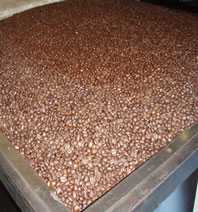FLAVORINGS-RELATED LUNG DISEASE


Coffee Processing Facilities
Workplace Interventions
Administrative Controls
Administrative controls are employer-dictated work practices and policies to reduce or prevent exposures to workplace hazards. The effectiveness of administrative changes in work practices for controlling workplace hazards is dependent on employer commitment and employee acceptance. Examples of administrative controls are the following:
- Ensuring workers understand the potential hazards in the coffee roasting industry (e.g., obliterative bronchiolitis and asthma) and how to protect themselves. OSHA’s Hazard Communication Standard, also known as the “Right to Know Law” (29 CFR 1910.1200) requires that employees are informed and trained of potential work hazards and associated safe practices, procedures, and protective measures.
- Covering containers of roasted ground or whole bean coffee and flavorings when not in use.
- Using vacuums with high-efficiency particulate air (HEPA) filters and wet methods to clean instead of compressed air, wherever feasible.
- Encouraging employees to report new, persistent, or worsening respiratory symptoms (such as cough, shortness of breath on exertion, and/or wheezing) to their personal healthcare providers and, as instructed by their employer, to a designated individual at their workplace. The occurrence of new or ongoing respiratory symptoms in the workforce should prompt consideration of work-related lung disease, medical referral, and re-evaluation of the potential for exposure to respiratory hazards.
- Page last reviewed: January 27, 2016
- Page last updated: January 27, 2016
- Content source:
- National Institute for Occupational Safety and Health Respiratory Health Division


 ShareCompartir
ShareCompartir